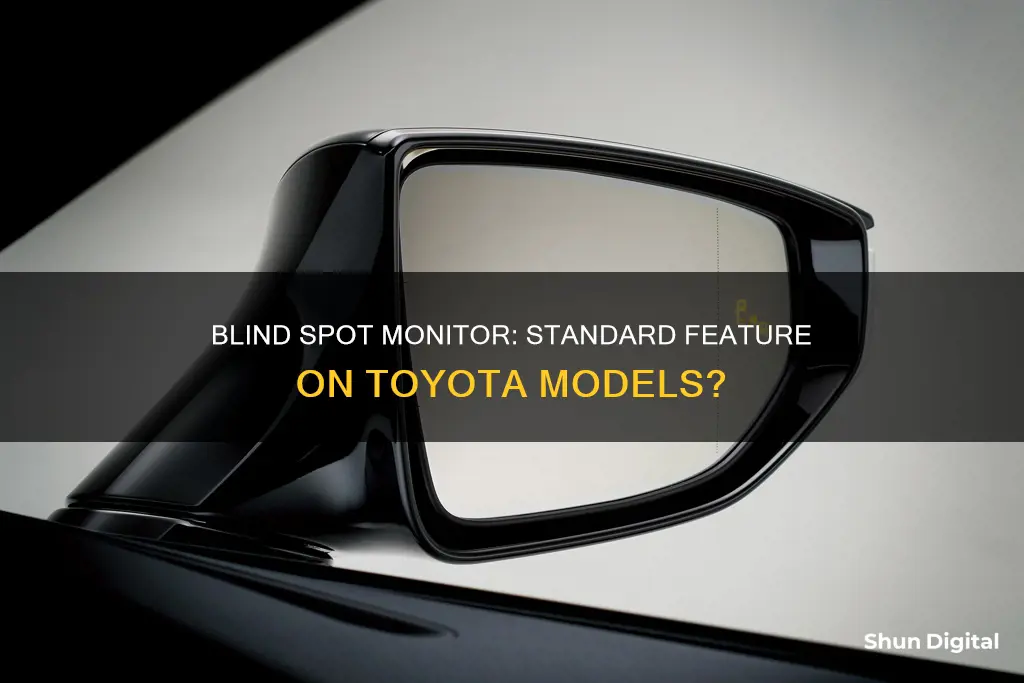
Blind-spot monitoring is a safety feature in cars that alerts the driver about vehicles approaching in the next lane. This feature is especially useful when changing lanes or turning. While the feature is not standard on all Toyota models, it is available as an upgrade on some of their vehicles, including the Camry, RAV4, and Corolla. The system is known as the Blind Spot Monitor on Toyota and Lexus vehicles.
The Blind Spot Monitor uses sensors on the side mirrors or rear bumper to detect vehicles in adjacent lanes. When the system detects a vehicle, it alerts the driver through visual or audio cues. While this feature is intended to improve safety, it is important to note that drivers should still manually check their blind spots when changing lanes or turning.
| Characteristics | Values |
|---|---|
| Is blind-spot monitoring standard on Toyota? | No, it is not standard on all Toyota models. It is included on mid- and high-level variants of the Camry and RAV4 but is a paid add-on for the Corolla. |
| How does it work? | Blind-spot monitoring uses side- and rear-mounted sensors to scan the areas alongside and behind the vehicle. When these sensors detect an object, they trigger a light in the driver’s line of sight and may also beep to indicate that it is not safe to move over. |
| Effectiveness | A study by the AAA found that blind-spot monitoring systems struggled to detect fast-moving vehicles and motorcycles. However, a study by the Insurance Institute for Highway Safety found that vehicles equipped with blind-spot monitoring systems were 14% less likely to be involved in a lane-change crash than those without it. |
| Drawbacks | The biggest issue is the technology's inability to detect fast-moving vehicles efficiently, with alerts often being provided too late for the driver to take action. Another drawback is that visual cues in the side mirror may be difficult for the driver to notice, especially in bright light. |
What You'll Learn

Toyota's blind spot monitor is called the Blind Spot Monitor
Blind Spot Monitors are an increasingly common feature in modern cars, and Toyota is no exception. The Blind Spot Monitor is a safety feature that alerts the driver to any vehicles approaching in the next lane. This is done through either an audible or visual warning, such as a flashing light or beeping noise.
The Blind Spot Monitor is not standard on all Toyota models. On some models, it is only available as an upgrade for an additional cost. However, on mid- and high-level variants of popular models like the Camry and RAV4, the Blind Spot Monitor is included as a standard feature.
The Blind Spot Monitor is particularly useful when backing out of a parking spot, changing lanes, or turning. It can also be helpful when driving on busy highways or in heavy traffic, as it can detect vehicles in adjacent lanes that may be difficult for the driver to see.
While the Blind Spot Monitor is a valuable safety feature, it is important to note that it should not be solely relied upon. Drivers should still check their blind spots and follow best practices when changing lanes or turning. Additionally, studies have shown that blind-spot monitoring systems may struggle to detect fast-moving vehicles or motorcycles, providing alerts too late for the driver to take action.
Overall, the Blind Spot Monitor is a helpful feature that can enhance safety and provide peace of mind when driving a Toyota vehicle.
Blind Spot Monitoring: Is It Available on Corollas?
You may want to see also

Blind spot monitoring is a sought-after driver aid
Blind-spot monitoring (BSM) is an active driver aid that enhances safety by alerting drivers to potential hazards in their blind spots. It is particularly useful for changing lanes or merging, as it can detect vehicles in adjacent lanes that human eyes may miss. BSM has evolved from a novelty feature in premium cars to a sought-after driver aid that is now available in various vehicles, including economy cars.
BSM typically uses side- and rear-mounted sensors, such as radar or ultrasonic sensors, to scan areas alongside and behind the vehicle. When an object is detected, the system alerts the driver through visual and/or audible warnings, such as a flashing light near the side mirror or an audible beep. This helps prevent accidents and increases driving awareness, providing an extra layer of security and confidence for the driver and passengers.
The effectiveness of BSM in preventing collisions has been demonstrated in studies. According to the Insurance Institute for Highway Safety, vehicles equipped with BSM systems have a 14% lower chance of being involved in lane-change crashes and a 23% reduction in injuries from such crashes. This makes BSM a valuable feature for vehicles of all sizes, especially larger ones with bigger blind spots.
While BSM is not standard on all vehicles, it is becoming increasingly available as a stand-alone option or as part of an option package. Some automakers charge a premium for BSM, but it is often included in mid- and high-level variants of popular models. Aftermarket BSM kits are also available for older vehicles, offering similar benefits at a cost.
Overall, blind-spot monitoring is a valuable driver aid that enhances safety and provides peace of mind for drivers and passengers. Its ability to prevent accidents and increase driving awareness makes it a sought-after feature for many vehicle owners.
How Holter Monitors Measure EF and Cardiac Health
You may want to see also

It's not standard on all Toyota models
Blind-spot monitoring is not standard on all Toyota models. The feature is included in mid- and high-level variants of the Camry sedan and RAV4 compact crossover. However, for the base models, buyers have to pay extra to add this feature. For example, for the entry-level Corolla, Toyota charges a premium of $1,340 to include blind-spot monitoring.
The blind-spot monitoring feature is not included in all Toyota models, and when it is offered as an upgrade, it can be quite expensive. For instance, Honda charges at least $2,010 extra for this feature on its Accord model, and $2,510 extra on its CR-V model.
While blind-spot monitoring is not standard on all Toyota models, it is available as an upgrade on certain vehicles. The feature uses sensors on the side mirrors or rear bumper to detect approaching vehicles in adjacent lanes and alerts the driver through audio or visual cues.
Some Toyota models, such as the Camry sedan and RAV4 compact crossover, include blind-spot monitoring as a standard feature on mid- and high-level variants. However, for other models, such as the Corolla, it is only available as an upgrade for an additional cost.
The effectiveness of blind-spot monitoring has been studied by various organizations, including the American Automobile Association (AAA) and the Insurance Institute for Highway Safety. While the feature has been shown to reduce lane-change collisions and related injuries, it may struggle to detect fast-moving vehicles or provide alerts in time for the driver to take action.
The Market for CPU Monitors: Who's Buying?
You may want to see also

Blind spot monitoring is an effective safety feature
Blind-spot monitoring is an effective safety feature that can help prevent accidents and enhance driving awareness. It is designed to alert the driver of vehicles, objects, or pedestrians in their blind spots, particularly when changing lanes or reversing. This feature is especially useful for larger vehicles with bigger blind spots and when driving in busy areas or tight spaces.
The system typically uses sensors and sometimes cameras mounted on the side mirrors or rear bumper to detect obstacles in adjacent lanes. When an object is detected, the driver is alerted through visual or audible warnings, such as flashing icons on the side mirrors or warning chimes. Some advanced systems even provide steering assistance by nudging the vehicle back towards the centre of the lane or applying the brakes to avoid a collision.
While blind-spot monitoring is not standard on all vehicles, it is becoming increasingly available across different car brands and models, including Toyota. It is often bundled with other safety features like rear cross-traffic alert, which is particularly useful when reversing out of parking spots.
Although blind-spot monitoring is a valuable safety tool, it should not replace the driver's responsibility to check their blind spots manually. The technology has some limitations, such as struggling to detect fast-moving vehicles or motorcycles, and may not always provide alerts in time for the driver to take action. However, when used in conjunction with safe driving practices, blind-spot monitoring can significantly enhance safety and reduce the risk of accidents.
Overall, blind-spot monitoring is an effective safety feature that can provide drivers with increased awareness, confidence, and peace of mind, ultimately contributing to a safer driving experience.
Hooking Up Your Sceptre Monitor: A Step-by-Step Guide
You may want to see also

It's not a substitute for good driving practices
Blind-spot monitoring (BSM) is a useful feature to have in your car, but it should not be a substitute for good driving practices. While BSM can help prevent accidents, it is not foolproof and has some limitations. For example, studies have shown that BSM systems can struggle to detect fast-moving vehicles and motorcycles, providing alerts too late for the driver to take action. Additionally, BSM systems may only function at certain speeds, and not all systems can recognize pedestrians, cyclists, or pets.
Therefore, it is important for drivers to maintain good driving practices and not become reliant on BSM. Drivers should still check their blind spots when changing lanes or turning and use their mirrors properly. Properly adjusting your mirrors can help eliminate blind spots, and it is recommended to consult your car manual to ensure your BSM is set up correctly. Keeping your cameras and sensors free of dust, mud, or snow will also maximize the effectiveness of the system.
While BSM can provide an extra set of "electronic eyes" to help keep you safe, it should be used as a supplementary tool to your own cautious driving practices. A good driver will stay alert and aware of their surroundings, using BSM as an additional safety feature rather than a replacement for safe driving techniques.
Furthermore, BSM is not standard on all vehicles. While it trickled down from luxury cars to economy cars, it is not mandatory on all passenger cars, SUVs, and light trucks. As a result, you may need to purchase a vehicle with a higher trim level or a stand-alone option to obtain BSM.
In conclusion, while blind-spot monitoring can be a valuable tool for drivers, it should not replace good driving practices. By using BSM in conjunction with safe driving techniques, you can maximize your safety on the road and minimize the risk of accidents.
Starting a Business: Security Monitoring a Priority, Not an Afterthought
You may want to see also
Frequently asked questions
No, Toyota includes blind spot monitoring on mid- and high-level variants of the popular Camry sedan and RAV4 compact crossover but makes base-model buyers shell out $680 extra for it.
It costs $680 to add blind spot monitoring to a base-model Toyota Camry. On the entry-level Corolla, blind spot monitoring is a $1,340 option.
Blind spot monitoring is one of the most sought-after driver aids and is proven to reduce accidents. A study by the Insurance Institute for Highway Safety found that vehicles equipped with blind-spot monitoring systems were 14% less likely to be involved in a lane-change crash than those without it.
Blind spot monitoring uses a pair of sensors situated on the side mirrors or the rear bumper to detect approaching vehicles in adjacent lanes. If the system detects a moving vehicle, it will alert the driver via an audible or visual warning.







